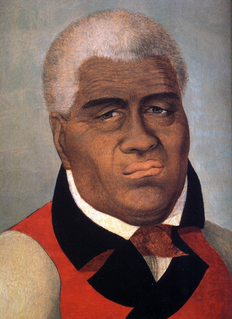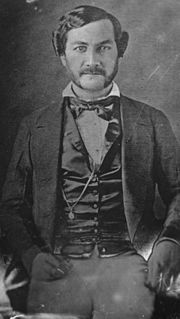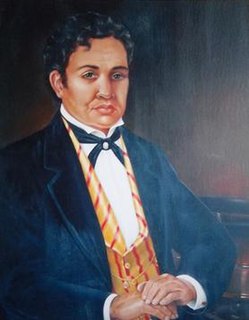Related Research Articles

Kamehameha I, also known as Kamehameha the Great, was the conqueror and first ruler of the Kingdom of Hawaii. The state of Hawaii gave a statue of him to the National Statuary Hall Collection in Washington, D.C. as one of two statues it is entitled to install there.

The House of Kamehameha(Hale O Kamehameha), or the Kamehameha dynasty, was the reigning Royal Family of the Kingdom of Hawaiʻi, beginning with its founding by Kamehameha I in 1795 and ending with the death of Kamehameha V in 1872 and Lunalilo in 1874. The kingdom would continue for another 21 years until its overthrow in 1893 with the fall of the House of Kalakaua.

John Adams Kiʻiapalaoku Kuakini (1789–1844) was an important adviser to Kamehameha I in the early stages of the Kingdom of Hawaii. He was responsible for contributing to the infrastructure among other changes in the Kona District during this era.

Keōua Kalanikupuapaʻīkalaninui Ahilapalapa, sometimes called Keōua Nui was an Ancient Hawaiian noble and the father of Kamehameha I, the first King of united Hawaiʻi. He was progenitor of the House of Keōua Nui. His first name Keoua, or Ke-ao-ua means "the rain cloud" and was given to him by his subjects because of his generosity and his sacred kapu of the heavenly rains.

Keoni Ana, full name John Kalaipaihala Young II, was a politician in the Kingdom of Hawaii, serving as Kuhina Nui of the Hawaiian Islands and Minister of Interior.
The Aliʻi nui of Maui was the supreme ruler of the islands of Maui, one of the four main Hawaiian Islands as well as the smaller island of Lanai. The title is the same as that of the Aliʻi nui of the other islands. The title or phrase Mōʻī is sometimes used for the title of the monarchs of Maui; however, it is not an ancient word in the Hawaiian language and has origins in the mid 19th century. The only monarchs to officially hold the title of Mōʻī are Kalākaua and his sister Liliuokalani.
Keʻeaumoku Pāpaʻiahiahi (1736–1804) was a Hawaiian high chief and the father of Kaʻahumanu. He was the principal agent in elevating Kamehameha I to the throne of Hawaiʻi and served in a capacity similar to commander in chief or Prime Minister. He is sometimes referred to as Keʻeaumoku II Pāpaʻiahiahi numbering Keʻeaumoku Nui as the first and his son as the third.
Helena Kalokuokamaile Wilcox Salazar-Machado was an aspirant head of the royal family of the Kingdom of Hawaii.

Gideon Kailipalaki-o-Kinaʻu Keheananui Laʻanui (1840–1871) was a great grandnephew of Kamehameha the Great, being a great grandson of Kalokuokamaile, the eldest brother of Kamehameha the Great. He was a member of the royal House of Laʻanui, a collateral branch of the House of Kamehameha.
The House of Keōua Nui(Hale O Keōua Nui), or simply House of Keōua, is the extended royal family of Ancient Hawaii from which the reigning family of Kamehameha I and Lunalilo were descended.
Kaʻōhelelani or Kaohele was a Hawaiian chiefess in the early Kingdom of Hawaii.

Gideon Peleʻioholani Laʻanui (1797–1849) was a Hawaiian chief and the grandnephew of Kamehameha the Great, who unified the Hawaiian Islands in 1810. From him descends the House of Laanui.
Kalanikauleleiaiwi was a Chiefess on the island of Hawaiʻi in the late 17th century and early 18th century. She was considered to be the co-ruler of the island of Hawaiʻi with her half-brother, Keaweʻīkekahialiʻiokamoku, the 21st King of Hawaii. Their shared mother was Keakealaniwahine, the ruling Queen of Hawaii. Their son, Keʻeaumoku Nui, was considered the highest rank of Piʻo and the rightful successor in rank to his father and mother.
Kekuʻiapoiwa II was a Hawaiian chiefess and the mother of the king Kamehameha I.
The House of Laʻanui is a family of heirs to the throne of the Kingdom of Hawaiʻi collateral to the House of Kamehameha. Both houses are branches of the House of Keōua Nui.
Kalanimālokuloku-i-Kepoʻokalani Keliʻimaikaʻi was a High Chief and the most popular brother of Kamehameha the Great, who founded the Kingdom of Hawaii.
Pauli Kaʻōleiokū was a Prince of Hawaii.
Kekuʻiapoiwa Liliha was a queen of the island of Hawaiʻi.
Kānekapōlei was a Native Hawaiian aliʻi wahine (queen) and wife of Kalaniʻōpuʻu, aliʻi nui of the Island of Hawaii and aunt of Kamehameha I, who were all present at Captain James Cook's death. She called attention to the kidnapping of her husband by Cook and his men, attracting his royal attendants to the beach, answering her calls for help.
Ke AliʻiKilinahe was a kaukau aliʻi noble who served under the ruling ali'i nui of the islands of Hawaii, Maui and Oahu, during the Kingdom of Hawaii. He is of the House of Moana and a collateral family of the House of Kamehameha. He performed his hana lawelawe or "service task" under Ka'ahumanu and Kamehameha III, starting as a kāhili bearer and royal attendant. He was brought into the Royal Court by Charles Kanaina to assume all of his duties and responsibilities. He toured Oahu with the Royal Circuit and managed the chief's goods. Kilinahe, in the Hawaiian language, means "light rain".
References
- 1 2 Elizabeth Kekaaniauokalani Kalaninuiohilaukapu Pratt (2009) [1920]. History of Keoua Kalanikupuapa-i-nui: father of Hawaii kings, and his descendants. republished by Kessinger Publishing. ISBN 978-1-104-76661-0.